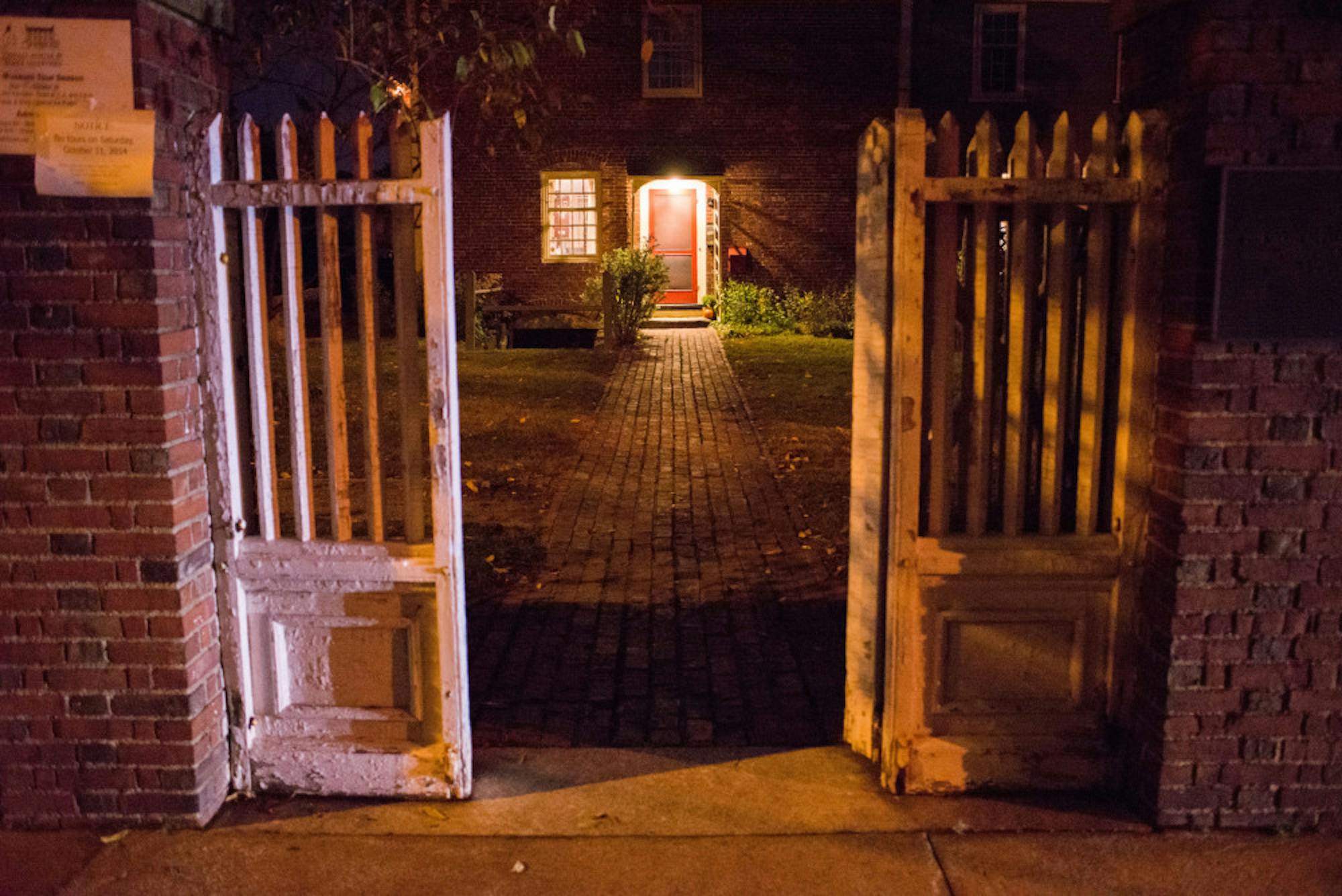Located less than a half-mile from the Joyce Cummings Center, the Royall House and Slave Quarters was an integral part of the Ten Hills Farm that functioned as a slave plantation and encompassed current land now a part of the Tufts campus. The Slave Quarters serve as a painful reminder of the impacts of slavery on systemic social and economic conditions that disproportionately harm communities of color.
The Slave Quarters also function as an example of Tufts’ relationship with slavery. The family of Charles Tufts, the founder of the university, accumulated wealth that was maintained over generations due to his family’s involvement in the Medford slave economy. The Slave Quarters was the locus of this involvement.
The central figure of this involvement was Isaac Royall Jr. After his slave-trading father Isaac Royall Sr. purchased the Slave Quarters in 1732 and died in 1739, Royall Jr. inherited the property at the age of 20. Royall’s ownership of enslaved Africans enabled him to become one of the wealthiest men in the Massachusetts Bay Colony during his time.
The Royall House and Slave Quarters now serves as a museum in Medford, Mass.Kyera Singleton, the executive director of the Royall House and Slave Quarters, understands how the legacy of Royall Jr.’s enslavement of Africans continues to reverberate through local communities of color and impacts broader struggles for racial equality.
Singleton outlined how the Royall family became embedded in slavery.
“Isaac Royall Sr. was originally from Massachusetts. He [and] his family [were] in Dorchester,” Singleton said. “He actually leaves, like many white colonists do at the time, to try to make their wealth in the transatlantic slave trade. So, he ends up in Antigua, running and owning one of the largest sugarcane plantations in Antigua, … and then they moved back to Massachusetts in 1737.”
Alexandra Chan, an archaeologist and former visiting assistant professor of anthropology at Vassar College, further explained the Royall family dynamics and some of Royall Jr.’s motivations in maintaining the Slave Quarters.
“Isaac [Royall] Sr. made [the Royall House and Slave Quarters] a country estate … but Isaac [Royall] Jr. wanted to display his riches and made himself the center of elegant hospitality, and threw soirees and parties all the time,” Chan said. “[Isaac Royall Jr.] made all these big improvements on the house. … He tried to make it look more like a Roman villa. … There was some grandiosity about him that his father didn’t seem to have.”
In Chan’s 2007 book, “Slavery in the Age of Reason: Archaeology at a New England Farm,”she details the type of labor that Royall Jr. forced enslaved people to perform. Such labor had significant implications for the broader nature of Northern and Southern slavery. Chan outlined the characteristics of enslaved labor in the North.
“The overwhelming majority of [enslaved people in New England] … were generalist farmhands [who performed] basic domestic work … because the economy did not support gigantic plantation-style farms,” Chan said.
Exploiting enslaved people for capital, Royall Jr. used such wealth to ingratiate himself with the Medford and Massachusetts social and political elite. From 1743–52, he served as a deputy to the Massachusetts Bay Colony General Court and became a noteworthy figure through other avenues. Such avenues included a 22-year commitment as a member of the Governor’s Council from 1752–74.
Singleton spoke to how well-connected Royall Jr. was to elite leaders.
“The [Royall] family was extremely well-connected, [and they were] extremely wealthy,” Singleton said.“Isaac Royall Jr. [became] a very prominent businessman. Not only does he own property [through the Slave Quarters], but he [owned] another plantation in Bristol, R.I. He owned other property in western Massachusetts.”
Royall Jr. knew many people, and one of those people was Simon Tufts, an ancestor of Charles Tufts. A prominent Medford physician and member of the General Court, Simon Tufts was embedded in similar social and political circles as Royall Jr. The two developed a working relationship that endured through the American Revolutionary War. Because his family were loyalist supporters of the British empire and built their wealth from slavery based on ties to the empire, Royall Jr. became a target and left his Quarters to go to Nova Scotia three days before the Battle of Lexington in 1775.
Singleton described what Tufts then did to help Royall Jr.
“Simon Tufts was the administrator of Isaac Royall Jr.’s estate once he fled for Nova Scotia and then England at the start of the Revolutionary War,” Singleton said. “Tufts was … the person that Isaac [was] writing to instruct [Tufts] to try to sell some of his enslaved people when he is struggling financially [and] once he is no longer in the country.”
The evidence for Royall Jr. and Tufts’s partnership is clear. A receipt dating back to Aug. 6, 1777, provided by the University of New Hampshire’s Milne Special Collections and Archives, was given to Royall Jr. by Tufts for turning in eight pounds of counterfeit New Hampshire bills.
Royall Jr. and Tufts developed a friendship and deep admiration for each other that is further evidenced by the correspondence between them, along with communication between Tufts and close confidants. In a letter dated from March 28, 1780, which was provided by the Charlotte and William Bloomberg Medford Public Library Archives, Royall Jr. writes to a confidant about Tufts’ attempts to defend Royall Jr. amid legal challenges.
“Some time past I received a letter from my attorney, Dr. Simon Tufts at Medford … wherein he says that the committee of Medford for the last year voted my estate out of his hands, as they said I was an absentee, and forbade him having anything further to do with it,” Royall Jr. wrote. “I have wrote Doc. Tufts and desired him … to sign a suitable petition or memorial in my name and behalf or my attorneys to the General assembly, setting forth … the true causes of my leaving the Province at the commencement of the [American Revolutionary] war.”
In another letter dated from April 18, 1780, which was also provided by the Charlotte and William Bloomberg Medford Public Library Archives, Tufts informs Royall Jr. about proceedings regarding his estate in Bristol, R.I.
“Not having the opportunity to send the foregoing, I come now to acquaint you that we have been called again to defend your Estate at Bristol,” Tufts wrote. “I am sorry that I have to continue this disagreeable topic by telling your Honor That this State have also Filed a Bill against your Estate to be heard and determined at Concord. … Great Perplexity attend me, as not a Day passes but have something to do about the Estate and after all can’t save it.”
Simon Tufts was not the only Tufts family member who was involved in slavery alongside the Royalls. According to public records provided by the Royall House and Slave Quarters, Timothy, Samuel and Aaron Tufts leased the Royall House for seven years starting in 1769. Based on genealogical data that is housed at the Tufts Archival Research Center, Timothy, Samuel and Aaron Tufts were cousins of Simon Tufts.
A significant reason why the Tufts family name was prominent at the time was because of the family’s wealth gained from slavery. This elevated their social status and was likely one factor that later helped Charles Tufts become a community leader in his generation.
Singleton discussed the implications of the Tufts family’s involvement in slavery.
“We often think about historical actors based on their individual actions, but some of the [Tufts] family members [were building wealth through ties to] the business of slavery,” Singleton said. “When you start to … follow the money, and you start to look at the relationships, you see that it is not so simple as [finding out whether] the Tufts founder was involved in slavery.”
Even with these facts, there are still open questions that contemporary scholarship surrounding local slavery in Medford and Boston seeks to address. Chan’s book attempted to discover more of the Slave Quarters’ history through archaeology.
Chan spoke about the historical gaps that still need to be filled regarding the Slave Quarters.
“One of the things that I am still waiting to learn more about is with regard to the plant and animal remains [found] at the [Slave Quarters],” Chan said. “Given this idea that [enslaved] people in the North had more freedom of movement [compared to enslaved people in the South], … one could expect that [activities such as hunting and fishing] that you find on slave sites in the South … might be amplified [at the Slave Quarters].”
Despite this, Chan said that she has not found evidence of enslaved people at the Slave Quarters engaging in hunting or fishing.
Local efforts to address slavery reflect national endeavors attempting to reconcile America’s legacy with slavery. One example came in 2019 through the 1619 Project, a New York Times initiative led by journalist Nikole Hannah-Jones that sought to discuss systemic issues borne from the legacy of slavery. Although the project remains controversial because of some of its characterizations of American slavery, it was one of many examples of a broader effort to reframe American history through the lens of slavery.
Kerri Greenidge, assistant professor of studies in race, colonialism and diaspora and co-director of the Tufts African American Trail Project at the Center for the Study of Race and Democracy spoke about the ideas that can better frame national conversation on slavery.
“One of the things I would suggest and I think [race, colonialism and diaspora] as a department … would say is that … starting with 1619 is [just] a way to frame the work that was done,” Greenidge said. “We know that the first African-descended person [arrived] on what [became] North America in roughly 1540. … That doesn’t mean that 1619 is irrelevant, but it means that if you want to get at the actual story of Tufts and Blackness, … we cannot have this overly broad view based on a specific moment in Virginia in 1619.”
Chan discussed how Tufts students can become more informed on the issue.
“The most important thing [Tufts students can do] is to stay open and curious,” Chan said. “I think that in our society today, the knee-jerk reaction for a lot of people when they come across uncomfortable knowledge is to just shut it down. ... I am not looking for anyone to feel shame. I am looking for people to be curious.”






